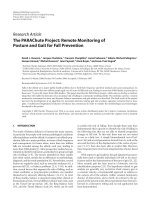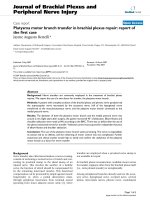The first project report remote draw
Bạn đang xem bản rút gọn của tài liệu. Xem và tải ngay bản đầy đủ của tài liệu tại đây (1.51 MB, 41 trang )
<span class="text_page_counter">Trang 1</span><div class="page_container" data-page="1">
<b>HCMC UNIVERSITY OF TECHNOLOGY AND EDUCATIONFACULTY FOR HIGH QUALITY TRAINING</b>
<b>INFORMATION TECHNOLOGY</b>
<b>THE FIRST PROJECT REPORTREMOTE DRAW</b>
<b>LECTURER NAME : Dr. Nguyen Dang Quang STUDENT NAME: Le</b>
<i>Ho Chi Minh City, December 2019</i>
</div><span class="text_page_counter">Trang 2</span><div class="page_container" data-page="2">2
</div><span class="text_page_counter">Trang 3</span><div class="page_container" data-page="3"><b>We express our sincere thanks to Mr. Nguyen Dang Quang, our project in charge,</b>
who guided us through the project. He gave valuable suggestions and guidance for completing the project, helped us to understand the intricate issues involved in project-making besides effectively presenting it. These intricacies would have been lost otherwise. Our project has been a success only because of his guidance. Projects are made within ten weeks, just enough to complete it. However, due to much new knowledge as well as the time we do through each week is not optimal, the project will have many errors, which is inevitable. We are looking forward to receiving all the comments of our teachers to help our limited knowledge better.
Sincerely thanks.
</div><span class="text_page_counter">Trang 4</span><div class="page_container" data-page="4">The purpose and objective of this training and mainly the content is time-being, and with this training, we have gained some confidence regarding introducing the application. We also believe that way we gained some sorts of IT knowledge, and if we practice much and having some expertise in the field, then we will be able to survive smartly in today’s competitive environment.
The effort to write the report is a partial fulfilment to complete the course. In the report, I try my best to represent all the content that we learned in a great deal in the program in a systematic and presentable order. I divided each of the topics as an individual chapter to reflect the entire topic more prominently and clearly. In reference, I have used the citation method in the entire report. Finally, I am very hopeful that the structure and topic of the report will be a useful material for all the reader, especially to the user.
</div><span class="text_page_counter">Trang 5</span><div class="page_container" data-page="5">3. Use case diagram ... 9
4. Use case description tables ... 11
II. Task Assignment ... 13
3. Graphic User Interface ... 35
IV. Test cases ... 36
</div><span class="text_page_counter">Trang 6</span><div class="page_container" data-page="6">5. Development ideas ... 37 Ref erences ... 38
</div><span class="text_page_counter">Trang 7</span><div class="page_container" data-page="7">Table1 – Use case Draw Shape description ... 11
Table2 – Use case Pen description ... 11
Table3 – Use case Invite description ... 11
Table4 – Use case Join description ... 11
Table5 – Use case Leave description ... 12
Table6 – Use case Export description ... 12
Table7 – Use case Chat description ... 12
Table8 – Work Plan ... 13
Table9 – Work Assignment ... 14
Table10 – List of classes are used in the client application ... 22
Table11 – List of methods in DrawingObject class ... 23
Table12 – List of methods on Shape class ... 23
Table13 – List of methods of Rectangle class ... 24
Table14 – List of methods of Ellipse class ... 25
Table15 – List of methods of Eraser class ... 25
Table16 – List of methods of Stroke class ... 26
Table17 – List of methods of Infrastructure class ... 26
Table18 – List of methods of Drawing class ... 29
</div><span class="text_page_counter">Trang 8</span><div class="page_container" data-page="8">Table19 – List of methods of ReadThread class ... 31
Table20 – List of methods of WriteThread class ... 31
Table21 – List of classes are used in the server application ... 31
Table22 – List of methods of Artboard class ... 32
Table23 – List of methods of Client class ... 32
Table24 – List of methods of Datasource class ... 33
Table25 – List of methods of UserThread class ... 33
Table26 – GUI explanation ... 35
Table27 – Test cases ... 36
<b>I. Project description</b>
1. Objectives
The drawing board provides users abilities to customise their drawings; we could find some applications such as Windows Paint, Artweaver, GIMP, etc. However, these programs only available for one user at a time. <b>Remote Draw </b>can allow multiple users to draw on board simultaneously through the network, which helps users spread their idea to other people more comfortable.
2. User benefits
Similarly to other drawing application programs, the Remote Draw provides users with the abilities to draw, move, and modify graphics objects. Essential drawing functions are:
Select: Select any shape and stroke on the artboard and move them to another position.
Undo: Return to the previous action.
Change colour: User can change colour with HSB, RGB and Web format. Change the thickness of a stroke or border width of a shape.
</div><span class="text_page_counter">Trang 9</span><div class="page_container" data-page="9">Erase: Clear everything when an eraser goes through, and the user can change the size of an eraser.
Pen: Draw strokes to canvas. Shape: Draw rectangle and ellipse.
Export: Export the artboard into the PNG format.
With the ability to connect to the Internet, Remote Draw application also allows users to invite one or more friends to draw together. Furthermore, after connecting, users and their friends can chat with each other to spread their ideas before drawing something.
3. Use case diagram
</div><span class="text_page_counter">Trang 10</span><div class="page_container" data-page="10"><i>Image 1 – Use Case Diagram</i>
</div><span class="text_page_counter">Trang 11</span><div class="page_container" data-page="11">4. Use case description tables
<i>Table 1 – Use case Draw Shape description</i>
Use case name Draw Shape
Description Allows user to draw a rectangle or an ellipse on the board
Preconditions Click the Shape button and choose a specific shape Conditions affecting
termination outcome
<i>Table 2 – Use case Pen description</i>
Use case name Pen
Description Allows user to draw any stroke on the board
Preconditions Click Pen button Conditions affecting
termination outcome
<i>Table 3 – Use case Invite description</i>
Use case name Invite
Description Allows user to invite other people to draw together
1 Click Invite button
between user and server
The server is running, the connection is established successfully The server is terminated, connection failed
<i>Table 4 – Use case Join description</i>
Use case name Join
Description Allows user to join to a remote board
1 Click Join button
2 A connection is established between user and server
3 The server sends all information of the remote board to the user 4 Render the drawing information to
</div><span class="text_page_counter">Trang 12</span><div class="page_container" data-page="12">the board Preconditions Server is running
Conditions affecting termination outcome
The server is running, the connection is established successfully The server is terminated, connection failed
<i>Table 5 – Use case Leave description</i>
Use case name Leave
Description Disconnect to server
1 Click Leave button
Preconditions User is connected to the server Conditions affecting
termination outcome
<i>Table 6 – Use case Export description</i>
Use case name Export
Description Exports the current state of the board to a png file
1 Click the export button
2 Show a dialogue for the user to choose the directory to store the
<i>Table 7 – Use case Chat description</i>
Use case name Chat
Description Allow users to communicate with each other
1 Enter the message to a text box 2 Click Send button
3 Send the message to the server to broadcast to other people that are connected to the same artboard 4 Display the message to the chatbox
</div><span class="text_page_counter">Trang 14</span><div class="page_container" data-page="14"><i>Table 9 – Work Assignment</i>
Building an Remote Draw software using Java
Everything drawn on the application is objects; these objects have attributes that define them, such as position, colour, etc. The role of application is rendering all those
</div><span class="text_page_counter">Trang 29</span><div class="page_container" data-page="29">Get the incoming message from the server
Get the outgoing message from the server
</div><span class="text_page_counter">Trang 32</span><div class="page_container" data-page="32">Pseudocode: none corresponding <b>y, String color, int penSize) Input: </b>
x, y, fill, color, penSize Output:
</div><span class="text_page_counter">Trang 33</span><div class="page_container" data-page="33">List of methods of ReadThread class
</div><span class="text_page_counter">Trang 34</span><div class="page_container" data-page="34"><i>Table 19 – List of methods of ReadThread class</i>
Pseudo code: none
Update socket ReadThrea d.java (86)
Le Duc Thinh
List of methods of WriteThread class
<i>Table 20 – List of methods of WriteThread class</i>
List of classes are used in the server application
<i>Table 21 – List of classes are used in the server application</i>
No. Class Name Responsible Purpose
Store information of an artboard such as code, drawingObjects and clients who are connecting to that artboard
</div><span class="text_page_counter">Trang 36</span><div class="page_container" data-page="36">List of methods of Datasource class
<i>Table 24 – List of methods of Datasource class</i>
Get a list of artboards that are stored in the server
Get a list of clients that are stored in the server
List of methods of UserThread class
<i>Table 25 – List of methods of UserThread class</i>
Find the artboard with the code that equals to the code from the client Send all graphics elements to the client
</div><span class="text_page_counter">Trang 37</span><div class="page_container" data-page="37"><b>artboard, Client client) </b>
Input: artboard, client. <b>artboard, Client client) </b>
Input: artboard, client. Output: none. Pseudocode: none.
Tell the client that it needs to update graphics <b>oard artboard, Client client, String data) Input:</b>
artboard, client, data.
</div>








